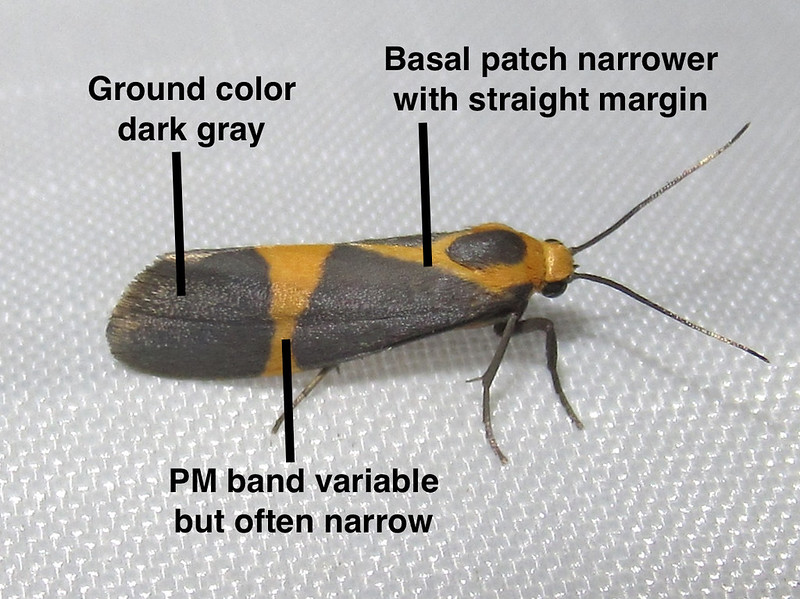Schwarz’s Lichen Moth Elevated to Species Status
I just got my copy of the brand new Pohl & Nanz “Annotated Taxonomic Checklist of the Lepidoptera of North America, North of Mexico” (Wedge Entomol. Res. Foundation, 2023). In it (p. 339), I see that Schwarz's Lichen Moth, Cisthene schwarziorum, has been elevated to species status (revised status) and is no longer considered a “western subspecies” of the Thin-banded Lichen Moth (C. tenuifascia). In that listing, Chris Schmidt (@neoarctia), author of the family Erebidae in the Checklist, does not cite references for the change, only mentioning that it is “based on differences in DNA and genitalic morphology”. This status change has been long anticipated. I previously addressed the identification of schwarziorum in field images in one of my Cisthene ID journal posts six years ago:
https://www.inaturalist.org/journal/gcwarbler/11815-id-guide-3-cont-d-thin-banded-lichen-moth-and-similar-species-in-texas
Schwarziorum was originally described as a full species by Dyar in 1899 but his schwarziorum was based on two specimens, one from Arizona and another from Vera Cruz, Mexico. The latter specimen has subsequently been determined to be the Tamaulipan Lichen Moth (C. subrufa, det. by Knowlton, 1967). Knowlton’s revision of the genus (1967, p. 70) placed Dyar’s Arizona schwarziorum as a synonym of tenuifascia, but provided only minimal details on that population. There is much variation in the color patterns of each species but below are the basic details of how to separate the two species in photos:

Cisthene schwarziorum, Graham Co., AZ; 22 Aug 2022; ph. C. Sexton

Cisthene tenuifascia, Mills Co., TX; 5 Oct 2019; ph. C. Sexton
Recognizing Schwarz’s Lichen Moth is fairly apparent in Arizona but trickier elsewhere. A large collection of images on iNat from Arizona correspond to the typical schwarziorum pattern with a complete, relatively broad yellowish PM band, an elliptic basal yellow patch which usually does not quite reach the PM band on the inner margin, and a ground color which is quite blackish. The color patches are usually pale to deep yellow but many examples are much oranger; these may represent fresher specimens:
https://www.inaturalist.org/observations?place_id=40&taxon_id=564194
Presently, another set of 80+ images in Arizona on iNat currently listed at species level as “Thin-banded” all appear to refer to proper Schwarz’s Lichen Moth and will need to be addressed individually:
https://www.inaturalist.org/observations?lrank=species&place_id=40&taxon_id=217048
As currently conceived, true Thin-banded Lichen Moth is not known to occur in Arizona.
In New Mexico, not unexpectedly from a biogeographical standpoint, a small number of observations in the s.w. part of the state appear to refer to Schwarz’s Lichen Moth, while a set of records from Albuquerque eastward (i.e. east of the Rio Grande) appear to be proper Thin-banded Lichen Moths:
https://www.inaturalist.org/observations?place_id=9&subview=map&taxon_id=217048
I tentatively put the ID of schwarziorum on a single observation in Utah, but my confidence in that ID is marginal:
https://www.inaturalist.org/observations?place_id=52&taxon_id=564194
Two observations on iNat from Sonora, Mexico are similar to the Arizona set:
https://www.inaturalist.org/observations?place_id=6794&taxon_id=564194
A disjunct set of observations in southern Mexico appear very similar to schwarziorum and deserve more detailed taxonomic study.
Jalisco: https://www.inaturalist.org/observations?place_id=7411&taxon_id=564194
Oaxaca: https://www.inaturalist.org/observations?place_id=8295&taxon_id=217048
Chiapas: https://www.inaturalist.org/observations?place_id=97003&taxon_id=217048





תגובות
As I often do, I'm having trouble formatting the embedded links in the various pieces of highlighted text. I'll work on correcting these.
Thanks for putting this together, Chuck. I'll put together a synopsis of the AZ species in the coming weeks with maps and images. So far I've only seen true schwarziorum as far north as roughly the Mogollon Rim. The UT record is interesting, I agree it does look more like this species than true tenuifascia, but it would be quite far outside of where they've been confimred from.
הוספת תגובה